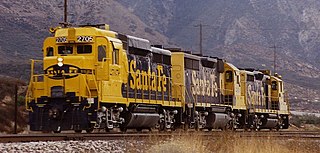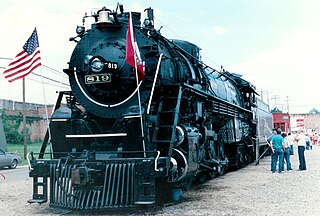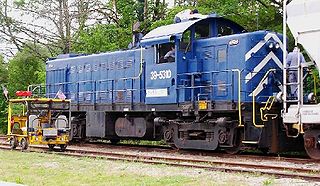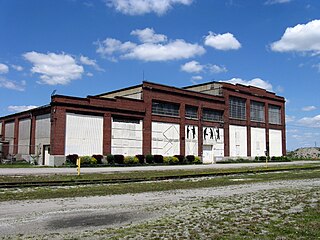
The Southern Pacific was an American Class I railroad network that existed from 1865 to 1996 and operated largely in the Western United States. The system was operated by various companies under the names Southern Pacific Railroad, Southern Pacific Company and Southern Pacific Transportation Company.

The EMD GP30 is a 2,250 hp (1,680 kW) four-axle diesel-electric locomotive built by General Motors Electro-Motive Division of La Grange, Illinois between July 1961 and November 1963. A total of 948 units were built for railroads in the United States and Canada, including 40 cabless B units for the Union Pacific Railroad.

The Virginia and Truckee Railroad is a privately owned heritage railroad, headquartered in Virginia City, Nevada. Its private and publicly owned route is 14 miles (23 km) long. When first constructed in the 19th century, it was a commercial freight railroad which was originally built to serve the Comstock Lode mining communities of northwestern Nevada.

The St. Louis–San Francisco Railway, commonly known as the "Frisco", was a railroad that operated in the Midwest and South Central United States from 1876 to April 17, 1980. At the end of 1970, it operated 4,547 miles (7,318 km) of road on 6,574 miles (10,580 km) of track, not including subsidiaries Quanah, Acme and Pacific Railway and the Alabama, Tennessee and Northern Railroad; that year, it reported 12,795 million ton-miles of revenue freight and no passengers. It was purchased and absorbed into the Burlington Northern Railroad in 1980. Despite its name, it never came close to San Francisco.

The St. Louis Southwestern Railway Company, known by its nickname of "The Cotton Belt Route" or simply "Cotton Belt", is a former Class I railroad that operated between St. Louis, Missouri, and various points in the U.S. states of Arkansas, Tennessee, Louisiana, and Texas from 1891 to 1980, when the system added the Rock Island's Golden State Route and operations in Kansas, Oklahoma, and New Mexico. The Cotton Belt operated as a Southern Pacific subsidiary from 1932 until 1992, when its operation was assumed by Southern Pacific Transportation Company.

The Indiana Railway Museum is a railroad museum located in French Lick, Indiana, United States, dedicated to preserving and displaying artifacts related to the history of railroads in Indiana.
The 5-mile (8.0 km) Reader Railroad was a tourist-only railroad operating in Hot Springs, Arkansas from 1973 to 1991. As a 23-mile (37 km) common carrier prior to May 1973, it was the last all steam locomotive-powered, mixed train railroad operating in North America. It operated trackage in Ouachita County and Nevada County, Arkansas. The five mile tourist railroad operated until 1991, when it could not meet the new federal safety regulations.

The Virginia Museum of Transportation is a museum devoted to the topic of transportation located in Downtown Roanoke, Virginia, US.

The Museum of the American Railroad, formerly known as the Age of Steam Railroad Museum, is a railroad museum in Frisco, Texas. The museum has more than 70 pieces of steam, diesel, passenger, and freight railroad equipment; guests may walk through some of the equipment on guided tours.

The Fort Eustis Military Railroad is an intra-plant United States Army rail transportation system existing entirely within the post boundaries of the United States Army Transportation Center and Fort Eustis (USATCFE), Fort Eustis, Virginia. It has served to provide railroad operation and maintenance training to the US Army and to carry out selected material movement missions both within the post and in interchange with the US national railroad system via a junction at Lee Hall, Virginia. It consists of 31 miles (50 km) of track broken into three subdivisions with numerous sidings, spurs, stations and facilities.

St. Louis Southwestern No. 819 is a class "L1" 4-8-4 "Northern" type steam locomotive and is also the official state locomotive of Arkansas. It was completed in 1943 and was the last engine built by the St. Louis Southwestern Railway, which was affectionately known as "The Cotton Belt Route" or simply "Cotton Belt". It was also the last locomotive built in Arkansas. It was restored to operating condition in 1986 and operated in excursion service until October 1993. As of 2022, the locomotive is now located at the Arkansas Railroad Museum, currently being cosmetically restored.

The Great Plains Transportation Museum is a railroad museum in Wichita, Kansas, United States.

The Southeastern Railway Museum is a railroad museum located in Duluth, Georgia, in suburban Atlanta.

Southern Appalachia Railway Museum is a railway museum headquartered in Knoxville, Tennessee, United States.

The North Alabama Railroad Museum, Inc. is a railroad museum in Chase, Alabama. The museum, incorporated in 1966, is an all volunteer organization. The museum has a collection of rolling stock, a small train station, and a small heritage railroad called the Mercury and Chase Railroad which operates between April and December. The mission of the NARM is to "preserve railroad history in North Alabama and South Central Tennessee." It is run entirely by its 100-plus volunteers. The museum is open to the public daily, volunteers are usually available on Wednesdays and Saturdays. Admission to the museum is free, however there is a charge for riding the trains. A schedule of rides is available at the museum's website.

The Elgin County Railway Museum is a rail transport museum in St. Thomas, Ontario.
The Wisconsin Great Northern Railroad operates a historic train line centered in Trego, Wisconsin on 26 miles of track, between Spooner, Wisconsin and Springbrook, Wisconsin. It was founded on April 1, 1997. The line runs dinner trains, bed and breakfast trains, and scenic sight seeing tours.
The St. Louis Southwestern Railway Caboose #2325 is a historic railroad caboose. It was built in 1920 by the St. Louis Southwestern Railway at its Pine Bluff, Arkansas shop, and is one of only a few surviving 2300-series cabooses. It was used by the railroad on its Paragould-Blytheville route, and was acquired by the Paperton Junction Southern Railway in 1980 and restored.

The St. Louis Southwestern Railway Relief Train is a railroad rescue and recovery train, its elements now on display at the Arkansas Railroad Museum in Pine Bluff, Arkansas. The train's principal feature is a large steam crane, built by Industrial Brownhoist of Bay City, Michigan in 1940. Other elements of the train include a boom car, generator flat, kitchen car, tool car, and crew sleeper. The boom car, a low gondola car, was attached to the train below the projecting section of the train; the other elements of the train supported the crew and the operation of the crane to clear derailments. The relief train was assembled by the St. Louis Southwestern Railway, and remained in active service until 1996, when it was given to the museum.

The Connecticut Eastern Railroad Museum is a railroad museum located on Route 32 in Willimantic, Connecticut. It was founded by members of the Connecticut Eastern Chapter of the National Railway Historical Society.




















